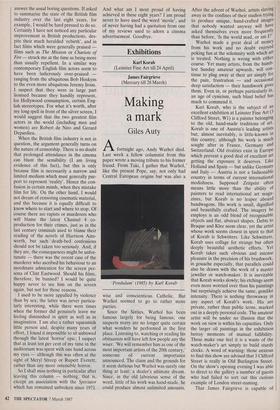Exhibitions
Karl Korab (Leinster Fine Art till 24 April) James Fairgrieve (Mercury till 28 March)
Making a mark
Giles Auty
Afortnight ago, Andy Warhol died. Last week a fellow columnist from this paper wrote a moving tribute to his former friend. From Taki, I gather that Warhol,' like the present Pope, say, not only had Central European origins but was also a
'Pendulum' (1985) by Karl Korab wise and conscientious Catholic. But Warhol seemed to go to rather more parties.
Since the Sixties, Warhol has been famous largely for being famous; one suspects many are no longer quite certain what wonders he performed in the first place. Listening to, watching or reading his obituarists will have left few people any the wiser. 'We will remember him as one of the most important artists of the 20th century,' someone of current importance announced. The claim and the grounds for it seem dubious but Warhol was surely one thing at least: a dealer's ultimate dream. Since, in the old laborious sense of the word, little of his work was hand-made, he could produce almost unlimited amounts. After the advent of Warhol, artists slaving away in the confines of their studios trying to produce unique, hand-crafted images that nobody wanted anyway will have asked themselves even more frequently than before, 'Is the world mad, or am I? Warhol made a great deal of money from his work and no doubt enjoyed poking fun at the solemnity with which art is treated. Nothing is wrong with either course. Yet many artists, from the humb- lest Sunday amateur upwards, will con- tinue to plug away at their art simply for the pain, frustration — and occasional deep satisfaction — their handiwork gives them. Even in, or perhaps particularly in, an age of cynicism, such blind belief has much to commend it.
Karl Korab, who is the subject of an excellent exhibition at Leinster Fine Art (3 Clifford Street, W1) is a painter belonging to the old, hand-made traditions of art. Korab is one of Austria's leading artists but, almost inevitably, is little-known In this country, although his work is much sought after in France, Germany and Switzerland. Old rivalries exist in Europe which prevent a good deal of excellent art getting the exposure it deserves. Like Holland and Spain — but unlike GermanY and Italy — Austria is not a fashionable country in terms of current international modishness. Supposed Zeitgeist often means little more than the ability of painters to read international art maga- zines, but Korab is no leaper aboard bandwagons. His work is small, dignified and beautifully crafted. The imagery he employs is an odd blend of recognisable objects and flat, abstract shapes. Debts to Braque and Klee seem clear, yet the artist whose work seems closest in spirit to that of Korab is Schwitters. Like Schwitters, Korab uses collage for strange but often deeply beautiful aesthetic effects. Yet Korab takes such obvious and intense pleasure in the precision of his brushwork, in gouache especially, that parallels could also be drawn with the work of a master jeweller or watch-maker. It is inevitable that Korab works slowly; his etchings seem even more worried over than his paintings but surprisingly achieve the same, gemlike intensity. There is nothing throwaway in any aspect of Korab's work. His are private, rather than public icons, marked out in a deeply personal code. The amateur artist will be under no illusion that the work on view is within his capacities. Only the larger oil paintings in the exhibition betray moments of manual fallibility.
These make one feel it is a waste of the watch-maker's art simply to build sturdy clocks. A word of warning: those anxious to find this show are advised that 3 Clifford Street is really in Old Burlington Street.
On the show's opening evening I was able to direct to the gallery a number of guests who had failed to sort out this curious example of London street-naming.
That James Fairgrieve is capable of precise and delicate painting is made clear by an exquisite small painting of a fresh- water fish in his show of work at Mercury Gallery (26 Cork Street, W1). For some strange reason the artist often mistrusts this facility and stumbles off into clumsier- looking mark-making. This is more of a Pity because his visual ideas are frequently arresting and full of poetic potential. Here is another example of an artist who seems to sense the weight of Modernism pressing on his shoulder and cannot fight free to pursue his deepest inclinations. An odd suppression of space and atmosphere brings certain of his farmyard landscapes closer to two-dimensional design than liv- ing experience. Yet Fairgrieve lives in the Border country, in Berwickshire, presum- ably because of his visual love of it.
Like the works of Korab, Fairgrieve's Paintings start to look strained when taken beyond certain dimensions. It is worth recalling that most artists have a natural scale and that size has never been the sole index of significance. Past examples such as Blake, Cotman and Palmer no less than more recent ones such as Klee, Miro and Schwitters provide all the proof that is needed. Making the right marks, no matter what their size, is what counts in the end.



























































 Previous page
Previous page